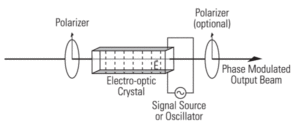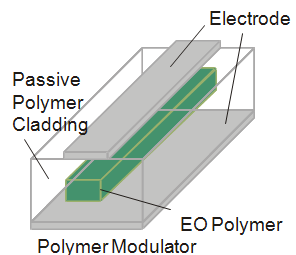Electro-optic modulators are increasingly becoming a vital component of optical processing systems. We have previously written about electro-optics generally, the different kinds of electro-optical modulators (and their applications), as well as covered the burgeoning domain of plasmonic electro-optic modulators but what exactly does the future have in stock for these optical components?
How Do Electro-Optic Modulators Work?
To understand how electro-optic modulators (EOM) work, we first need to understand the foundational electro-optic effect. The electro-optic effect describes the phenomenon wherein the optical properties of a material change in response to a varying electrical field. In practice, the electro-optic effect usually manifests as a change in either the refractive index or absorption of a material in response to a varying electric field. While the electro-optic effect has been exploited for a wide range of different optical devices, optical modulators utilize nonlinear crystalline materials which exhibit a linear refractive index change in response to a varying electric field, also called the Pockels effect.

Diagram of a electro-optical phase modulator. Adapted from Newport
The Pockels effect occurs only in nonlinear crystalline materials, such as lithium niobate (LiNbO3), and gives rise to the most important component of electro-optic modulators, Pockels cells. Pockels cells consist of a nonlinear crystalline material such as lithium niobate through which an optical light beam propagates, while a varying voltage is applied to the crystal, generally through parallel plate capacitors attached at each end of the crystal. Exhibiting the linear electro-optic effect, the frequency and magnitude at which a variable voltage is applied has a commensurate effect on the refractive index of the crystal, modulating the light beam which propagates through it. Such modulation can take the form of modifying the frequency, amplitude, phase, or polarization of the light, all of which may be used independently or in tandem for an electro-optic modulator to serve its purpose.
The varying manners in which electro-optic modulators can modify the properties of a traveling light wave allow for fast laser switching, switching of light to different optical wavelength regimes, and encoding of information in traveling light waves. As such, electro-optic modulators are currently used in a variety of domains, included but not limited to communications, information processing, and digital signal processing.
Considerations Before Purchasing an Electro-Optical Modulator
Because electro-optical modulators are used in a wide variety of applications and optical systems, the most important consideration one must make is the type of modulator needed for a given application – amplitude, frequency, phase, or polarization.
There are several auxiliary properties of electro-optic modulators which should inform the type of modulator one purchases, largely dependent on the optical system it is to be integrated into. For one, the nonlinear optical crystals, which serve as the basis of such devices, by their very nature are piezoelectric (voltage applied to the material causes mechanical deformation and vice versa), which means that unwanted temporary and permanent effects can be introduced in operation of the modulator in response to extreme or rapid fluctuations of the applied electric field. Such unwanted effects often occur when the input light is near the acoustic resonance of the modulating material, at which large lattice vibrations can cause extraneous refractive index fluctuations, interfering with the desired output signal.
One of the most important considerations when choosing a modulator system is whether it accepts broadband frequencies or is tailored to a resonant frequency. Resonant modulators are tuned to a specific frequency of incoming light, and as such, require less voltage to operate and are often easier to operate. Broadband modulators, on the other hand, can be operated over a variety of wavelengths, but to afford such an accommodation, require high voltage levels to operate.
Another important consideration over all electro-optic modulators is choosing a device which causes the least amount of damage to the input light wave – that is, one that has the lowest insertion loss. This generally means choosing a modulator with a broadband anti-reflection coating and large aperture size. Damage can also occur to the nonlinear crystalline material over the course of exposure to high powered light beams, which cause local migrations of charge carriers due to the photorefractive effect, essentially creating regions of extraneous refractive index change. For this reason it is important to compare the damage threshold of the material used in an electro-optic modulator relative to the optical beams it is expected to accept.
It is also important to tailor the modulator design to the application at hand – for instance, if you are choosing an electro-optic modulator for fiber-optic communication purposes, it would be wise to choose a modulator designed with fiber-coupled ends rather than a modulator designed for free-space beams.
Recent Advances in Electro-Optical Devices

Diagram of an electro-optical modulator with a polymer material as the electro-optic core. Adapted from Photonics Wiki
Many of the recent innovations surrounding electro-optic modulators lie in the developments of polymer crystalline materials as the beam propagation medium. While inorganic crystalline materials such as lithium niobate or tellurium oxide have been traditionally used, organic polymer-based electro-optic modulators and silicon-organic hybrid modulators have shown promise in reducing power consumption and required voltage, while maintaining or improving upon operation speed and increasing operating bandwidth. While there is still much research to do before such devices reach widespread feasibility, highly scalable and parallelizable manufacturing methods are being quickly developed.
Be sure to browse FindLight’s diverse catalog of electro-optic modulators and other photonic and optical devices on the FindLight marketplace.
